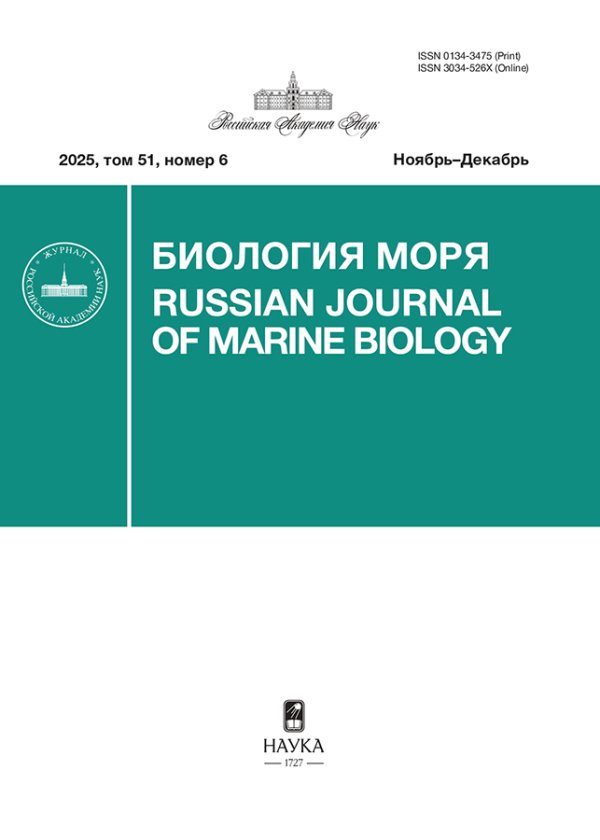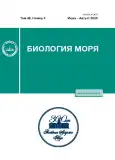The Fatty Acid Composition of a Deep-Sea Acorn Worm Quatuoralisia malakhovi Ezhova et Lukinykh, 2022 (Hemichordata: Enteropneusta)
- Authors: Rodkina S.A.1
-
Affiliations:
- Zhirmunsky National Scientific Center of Marine Biology, Far Eastern Branch, Russian Academy of Sciences
- Issue: Vol 49, No 4 (2023)
- Pages: 281-284
- Section: КРАТКИЕ СООБЩЕНИЯ
- Published: 01.07.2023
- URL: https://journals.rcsi.science/0134-3475/article/view/135145
- DOI: https://doi.org/10.31857/S0134347523040113
- EDN: https://elibrary.ru/ZQYRWW
- ID: 135145
Cite item
Full Text
Abstract
This study investigates the fatty acid (FA) composition of total lipids in Quatuoralisia malakhovi Ezhova et Lukinykh, 2022 (Hemichordata: Enteropneusta), a new species of deep-sea acorn worm that was collected on the slope of the Piip Volcano in the Bering Sea. The data obtained indicate that the main components of lipids in Q. malakhovi are fatty acids of bacterial and diatom origin. The food source of the studied species is detritus containing large amounts of not only bacteria, but also diatoms. The results could be used in trophic studies of communities that include Enteropneusta.
Keywords
About the authors
S. A. Rodkina
Zhirmunsky National Scientific Center of Marine Biology, Far Eastern Branch,Russian Academy of Sciences
Author for correspondence.
Email: srodkina@mail.ru
Russia, 690041 , Vladivostok
References
- Харламенко В.И., Кияшко С.И., Родькина С.А., Имбс А.Б. Идентификация источников пищи морских беспозвоночных из сообщества сублиторальных песков по составу жирных кислот и стабильных изотопов // Биол. моря. 2008. Т. 34. № 2. С. 115–123.
- Харламенко В.И., Кияшко С.И., Родькина С.А., Светашев В.И. Состав жирных кислот и стабильных изотопов у детритофага Acilainsignis (Gould, 1861) (Bivalvia: Nuculidae): поиск маркеров микробной пищевой сети // Биол. моря. 2011. Т. 37. № 3. С. 191–198.
- Харламенко В.И., Степанов В.Г., Борисовец Е.Э. и др. Состав жирных кислот и питание глубоководных голотурий Охотского моря // Биол. моря. 2015. Т. 41. № 6. С. 418–424.
- Barnathan G. Non-methylene-interrupted fatty acids from marine invertebrates: occurrence, characterization and biological properties // Biochimie. 2009. V. 91. P. 671–678.
- Berge J.P., Barnathan G. Fatty acids from lipids of marine organisms: molecular biodiversity, roles as biomarkers, biologically active compounds, and economical aspects // Adv. Biochem. Eng. Biotechnol. 2005. V. 96. P. 49–125.
- Bligh E.G., Dyer W.J. A rapid method of total lipid extraction and purification // Can. J. Biochem. Physiol. 1959. V. 37. № 8. P. 911–917.
- Budge S.M., Iverson S.J., Koopman H.N. Studying trophic ecology in marine ecosystems using fatty acids: A primer on analysis and interpretation // Mar. Mam. Sci. 2006. V. 22. P. 759–801.
- Budge S.M., Springer A.M., Iverson S.J., Sheffield G. Fatty acid biomarkers reveal niche separation in an Arctic benthic food web // Mar. Ecol. Prog. Ser. 2007. V. 336. P. 305–309.
- Cook H.W. Fatty acid desaturation and chain elongation in eukaryotes // Biochemistry of lipids and membranes. Amsterdam: Elsevier. 1996. P. 129–152.
- Dalsgaard J., St. John M., Kattner G. et al. Fatty acid trophic markers in the pelagic marine environment // Adv. Mar. Biol. London: Academic Press. 2003. V. 46. P. 225–340.
- Ezhova O.V., Lukinykh A.I., Galkin S.V. et al. Deep-sea acorn worms (Enteropneusta) from the Bering Sea with the description of a new genus and a new species of Torquaratoridae dominating soft-bottom communities // Deep-Sea Res. Part II. 2022. V. 195. https://doi.org/10.1016/j.dsr2.2021.105014
- Gunstone F.D. Fatty acid and lipid chemistry. Dordrecht: Springer Science + Business Media 1996. 252 p.
- Iverson S.J. Tracing aquatic food webs using fatty acids: From qualitative indicators to quantitative determination // Lipids in aquatic ecosystems. 2nd ed. New York: Springer. 2009. V. 12. P. 281–308.
- Jonasdottir S.H. Fatty acid profiles and production in marine phytoplankton // Mar. Drugs. 2019. V. 17. P. 151. https://doi.org/10.3390/md17030151
- Jones D.O.B., Alt C.H.S., Priede I.G. et al. Deep-sea surface-dwelling enteropneusts from the Mid-Atlantic Ridge: Their ecology, distribution and mode of life // Deep-Sea Res. Part II. 2013. V. 98. https://doi.org/10.1016/j.dsr2.2013.05.009
- Kelly J.R., Scheibling R.E. Fatty acids as dietary tracers in benthic food webs // Mar. Ecol. Prog. Ser. 2012. V. 446. P. 1–22.
- Kharlamenko V.I. Abyssal foraminifera as the main source of rare and new polyunsaturated fatty acids in deep-sea ecosystems // Deep-Sea Res. Part II. 2018. V. 154. P. 358–364.
- Kharlamenko V.I., Kiyashko S.I., Sharina S.N. et al. An ecological study of two species of chemosymbiotrophic bivalve molluscs (Bivalvia: Vesicomyidae: Pliocardiinae) from the Deryugin Basin of the Sea of Okhotsk using analyses of the stable isotope ratios and fatty acid compositions // Deep-Sea Res. Part I. 2019. V. 150. Art. ID 103058. https://doi.org/10.1016/j.dsr.2019.06.004
- Mansour M.P., Holdsworth D.G., Forbes S.E. et al. High contents of 24:6(n-3) and 20:1 (n-13) fatty acids in the brittle star Amphiura elandiformis from Tasmanian coastal sediments // Biochem. Syst. Ecol. 2005. V. 33. № 7. P. 659–674.
- Oxtoby L.E., Budge S.M., Iken K. et al. Feeding ecologies of key bivalve and polychaete species in the Bering Sea as elucidated by fatty acid and compound-specific stable isotope analyses // Mar. Ecol. Prog. Ser. 2016. V. 557. P. 161–175. https://doi.org/10.3354/meps11863
- Parrish C.C. Essential fatty acids in aquatic food webs // Lipids in aquatic ecosystems: 2nd ed. New York: Springer. 2009. V. 12. P. 309–326.
- Rybakova E., Galkin S., Gebruk A. et al. Vertical distribution of megafauna on the Bering Sea slope based on ROV survey // PeerJ. 2020. V. 8. Art. ID e8628. https://doi.org/10.7717/peerj.8628
- Springer A.M., McRoy C.P., Flint M.V. The Bering Sea Green Belt: shelf-edge processes and ecosystem production // Fish. Oceanogr. 1996. V. 5. P. 205–223.
- Svetashev V.I. Mild method for preparation of 4,4-dimethyloxazoline derivatives of polyunsaturated fatty acids for GC-MS // Lipids. 2011. V. 46. № 5. P. 463–467.
- Zhang J.B., Ren C.L., Zhang H. et al. Review of estimating trophic relationships by quantitative fatty acid signature analysis // J. Mar. Sci. Eng. 2020. V. 8. Art. ID 1030. https://doi.org/10.3390/jmse8121030
- Zhukova N.V. The pathway of the biosynthesis of non-methylene-interrupted dienoic fatty acids in mollusks // Comp. Biochem. Physiol. Part B. 1991. V. 100. P. 801–804.
Supplementary files










